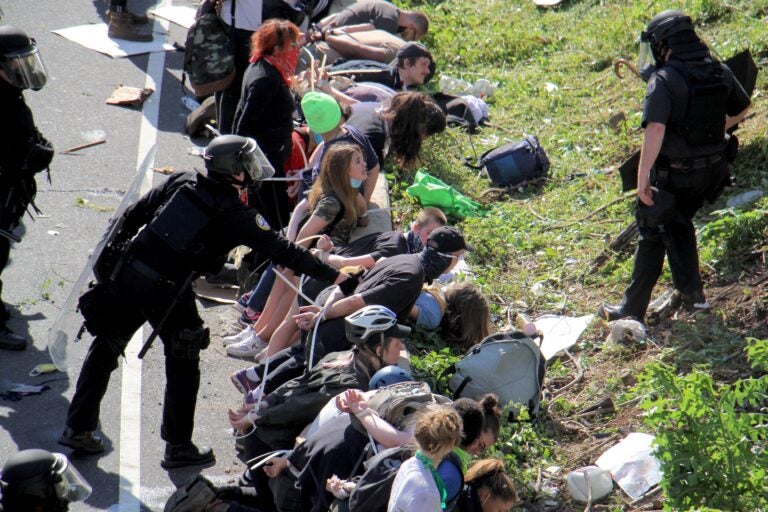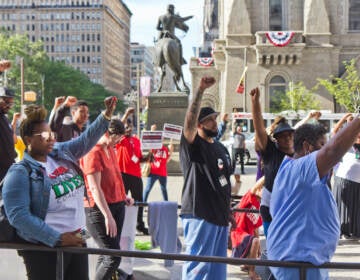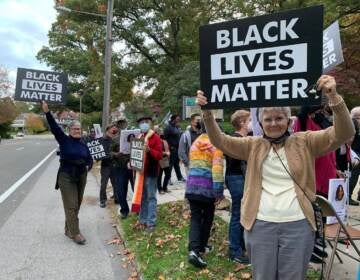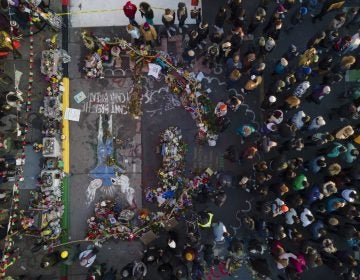Eyes blistering, crawling on highway: What it felt like to be tear gassed on 676
Fifteen people describe their violent encounter with police while protesting police brutality in Philadelphia.

Police line up protesters after tear gas was used on I-676 in Philadelphia. (Emma Lee/WHYY)
I fled up the highway embankment when the tear gas hit. Calling out to others not to run, I feared a stampede on I-676, where we had interrupted traffic with a peaceful Black Lives Matter march. With a history of head injury and other health conditions, I was vulnerable, like countless others protestors, to the chemical agents being set off by police. But none of that seemed to matter to the Philadelphia police officers who trapped us and fired multiple rounds of tear gas and pepper spray onto our peaceful act of civil disobedience.
Tear gas causes respiratory distress, burns, vomiting, and even blindness. It can incite stampedes, like the one about to come. While Philadelphia Mayor Jim Kenney and Police Commissioner Danielle Outlaw approved its use during protests, tear gas is considered a chemical weapon and formally banned in warfare by the 1993 Chemical Weapons Convention.
Even outside of war, governments can only use these riot control agents when they are necessary and proportionate to accomplish a specific law enforcement objective. The following firsthand accounts from that day raise serious questions about whether their use on 676 was, not only disturbing and shameful, but also unlawful.
‘Blood and screaming everywhere’
Christian Ann-Marie Cross, who grew up in North Philadelphia in the Richard Allen Projects before relocating to 27th and Girard Avenue, said she has attended many demonstrations but never experienced such fear while protesting. “I walked about a half mile before people started to scream, push, and run back. I couldn’t breathe, but I had to keep running. People were vomiting and yelling.”
Cross has been afraid to demand rights for her people in the past because of backlash she might face. “But if I don’t fight for what is right, what kind of world am I passing down to the beautiful black and brown babies? My young family members?” she asked.
Edward Parker has lived in Fern Rock all his life, aside from a stint outside the city while training in the National Guard. He got his BA in Criminal Justice from Temple. He studied criminal justice after growing up exposed to apathy from law enforcement and racism. Parker had witnessed police brutality before, but had never experienced it before getting tear gassed while peacefully protesting. “I had to slip out of their cuffs while face down to use my emergency inhaler,” he said. Once an officer realized what had happened, he helped Parker stand and breathe. “But if I hadn’t slipped out, I probably wouldn’t be here,” the protestor said.
Boston Gordon, 30, described losing their senses in the melee. “We took control of the highway, stopped traffic safely, and proceeded to march as we had been. The cops let loose tear gas and the crowd fled,” Gordon said. “I had to crawl up a hill, unable to breathe or see.”
Chris Bauer, who attended with his girlfriend, was alarmed that the only option for escape was a steep hill leading to an eight-foot tall fence. To the east and west, police had set off tear gas, and across the highway was an unscalable concrete barrier.
“There was blood and screaming everywhere,” Bauer said. “I went to the fence to try to find my girlfriend, where I was greeted by two police with shotguns pointed at me.” He was later treated by a medic at the scene.
Dan DiGiuseppe, a forty-something white male from the same “small town” in New Jersey where a corrections officer was recently recorded mocking George Floyd’s death, said he could no longer sit and watch from the sidelines.
He was on 676 when police released the chemical agent and was “about as far up as you could get without actually being in the tunnel.” He focused on “trying to get as many people over the fence as possible.” He remembers the people he could not help.
“I can still see the look on that girl’s face as I succumbed to the gas and couldn’t lift her,” DiGiuseppe said. “She just looked so disappointed in me. White shirt. Jeans. Light-skinned black female. If you are reading this, I’m so sorry.”
Andy Powers, 28, was alongside a journalist and a man in his fifties when he got hit with a rubber bullet. “Cops and military trapped unarmed non-violent civilians, reporters, and medics,” he said. “They threw gas as we attempted to flee over a nearby fence, shooting stragglers.”
Mohammad El Habbal and his two march partners were able to get out of the crowd and to nearby grass, where he saw people struggling to breathe.
“I witnessed, for the first time, the effects of tear gas. A woman’s eyes blistering shut. She was in so much pain, she couldn’t stop long enough for me to help her clean her eyes,” El Habbal recalled. He was able to help a man who had been gassed, giving him a homemade solution so he could continue the march.
George MacLeod of West Philly was injured while trying to climb the fence to escape. MacLeod believes that “a peaceful protest met with excessive force and injury proves the systemic problem of police brutality and the need to demilitarize the police.” He intends to get surgery for his dislocated shoulder.
Oscar Collado, a white Hispanic male from South Philly, said that though he is sad it has taken him this long to feel passionate, he knew it was time to take to the streets. During the incident, he says, authorities failed to warn protestors. “It seemed they strategically timed the tear gas to make running away more dangerous and hazardous because we were under an overpass.”
‘They had guns pointed at us’
Police put Philadelphians, who in the name of justice were putting their bodies on the line during a pandemic, at grave risk. They placed into immediate danger those drivers who got out to applaud, as well as motorists stuck in their cars. When the crowd peacefully dispersed onto Ben Franklin Parkway, a helicopter followed overhead, and police pursued in armored tankers, pepper spraying those who had their backs turned.
Lia Jefwa, former military deployed with the army in 2004 and again in 2005-06, said, “They knew exactly what they were doing. It caused panic, disorder, and I’m grateful nobody lost their life.”
Devin Rojas, who grew up in a military home and is married to a service member who is on active duty, was “raised to know what a uniform stands for.” But that didn’t make her experience any less traumatic. “They had guns pointed at us, Rojas said. “They had sticks ready to beat us. Even in the face of that violence, protestors stayed peaceful.
“They came looking for people to hurt, they came looking for black people to hurt,” Rojas said. Identifying as an “intelligent, racially conscious Latina,” she said she recognizes how systems are designed to enforce white supremacist ideology.
Sisters Hasadri and Kisara Freeman plan to march again, even though the experience on June 1 was “terrifying.” Kisara, 17, said “they trapped us and gassed us long before curfew.” Hasadri Freeman, 19, said “to the police, we are only a mass. They will gas us all, no matter if you are an elderly person or a child.”
Michelle Lee Delgado joined her first Philadelphia protest with others from the Creative Resilience Collective, a volunteer organization that leads educational and art workshops to change healthcare. She stood on Ben Franklin Parkway overlooking the highway. “It was beautiful until three cop cars burst through and we all panicked,” she said. “Why did they do that? Why did they throw gas at us?”
Our ask
In listening only to commanding officers and refusing to acknowledge these voices, the mayor and police continue to betray those they serve. To date, there is no evidence of a single violent act by protestors, and aerial footage contradicts the suggestion that protestors threw rocks, rushed the police, or surrounded a Pennsylvania State Trooper’s vehicle. In fact, videos show protestors walking right by him.
City Councilmember Helen Gym has called on leadership to “ask militarized forces to stand down.”
The only weapon protestors used was their collective voice.
Many more of us stand ready to testify to what happened.
We demand the right to assemble to protest police violence against black civilians and to demand justice for George Floyd, Ahmaud Arbery, Breonna Taylor and countless others victimized by police brutality in a culture of white supremacy.
We demand that Mayor Kenney acknowledge that chemical agents were employed without provocation, issue an apology for pre-authorizing , and commit Philadelphia to never again using tear gas or excessive force on a peaceful protest.
We demand that Mayor Kenney call on cities to stand with him against the deployment of chemical agents and the National Guard against their own people. A mayor who conceals the truth, especially about violence, can be no better than an officer, a president, a nation that does the same.
Annie Liontas lives in Philadelphia and is an assistant professor at George Washington University. She is the author of Let Me Explain You and co-edited A Manner of Being: Writers on their Mentors. She was among those attacked by police on highway 676.
Rachel López is an associate professor of law at Drexel University’s Kline School of Law, Former Commissioner on the Pennsylvania Sentencing Commission, and the Director of the Andy and Gwen Stern Community Lawyering Clinic. She has been providing legal advice on how to report police misconduct and other legal recourse to those who were attacked on highway 676.

Subscribe to PlanPhilly
WHYY is your source for fact-based, in-depth journalism and information. As a nonprofit organization, we rely on financial support from readers like you. Please give today.






